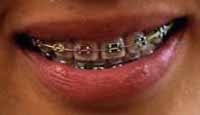Orthodontics/Braces
Orthodontics/Braces

What is orthodontics?
Orthodontics is the dental specialty that focuses on the development, prevention, and correction of irregularities of the teeth, bite, and jaws. Orthodontists also have specialized training in facial abnormalities and disorders of the jaw. You may see an orthodontist after getting a referral from your general dentist. Your dentist may recommend orthodontic treatment to improve your bite and the appearance of your face and teeth. However, the American Dental Association recommends that every child have an orthodontic evaluation by age 7.
Why choose orthodontic treatment?
Any orthodontic problem may be classified as a malocclusion, or "bad bite." Orthodontic treatment can help these problems:
-
Misaligned, crooked, or crowded teeth
-
Missing teeth
-
Extra teeth
-
An overbite
-
An underbite
-
An openbite
-
Misaligned or incorrect jaw position
-
A disorder of the jaw joint
-
Open spacing between teeth, including diasterna correction
-
Closed-spacing, overlapping, or crowding of teeth
-
Incorrect cross-arch overlapping or crossbite of teeth
At what age are braces appropriate?
Moving and correcting the alignment of the teeth follows the same process no matter what the age. However, an adult mouth must overcome already positioned facial bones and jaw structure. Overcoming most types of bite problems may need more than one type of orthodontic treatment for adults. In most cases, the ideal age for braces and other orthodontic treatments is between 10 and 14 years of age, although people of any age can benefit from treatment.
What are the different types of braces available?
Braces, also called fixed orthodontic appliances, generally come in three types:
-
Brackets, metal or plastic, clear or tooth-colored, that are bonded to teeth
-
Lingual-type brackets that attach to the back of teeth, hidden from view
-
Metal bands that wrap around and cover most of the teeth
All three types use wires to move the teeth to the desired position
Another type of orthodontic device that can be used is aligner therapy. Aligners are removable, custom-formed plastic guides that fit over the teeth. They are used in a series to move teeth to their desired positions.
Oral health care and braces
The following recommendations will help eliminate, or reduce, any oral health problems while your teeth are in braces:
-
Brush your teeth carefully after every meal with fluoride toothpaste and a soft-bristled toothbrush, as food becomes easily lodged in the braces. A new toothbrush may be needed every 3 to 4 months or sooner if bristles are broken or frayed. A worn toothbrush doesn't do a good job of cleaning the teeth.
-
Floss daily between the teeth and the braces. You may need a floss threader to guide the floss under the wire.
-
See an oral health professional for cleanings every 6 months or more often if instructed.
-
Limit your sugar and starch intake, as debris left behind from these types of foods may turn into damaging acids, which promote tooth decay and white spots around the braces.
-
Avoid hard and sticky snacks that may be difficult to remove from the orthodontic equipment in your mouth. This includes hard foods, such as popcorn, hard candy, nuts, and ice chips, and sticky foods like chewing gum, caramel, and other chewy candy.
Ask your dentist about the application of a fluoride treatment around the braces to minimize white spots on the teeth (caused by repeated attacks from plaque acids) after the braces come off.
Updated:
March 16, 2019
Reviewed By:
Kapner, Michael, DDS,Walton-Ziegler, Olivia, MS, PA-C